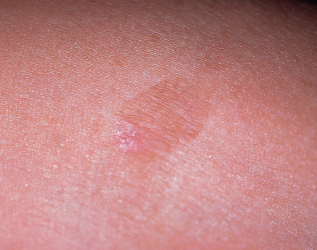Seborrheic Keratosis
What caused the color change in this pigmented lesion?

Changes in a pigmented lesion on her arm send a 68-year-old woman for medical consultation. A red area has recently developed in the long-standing, asymptomatic lesion.
Which of the following would you offer?
A. Reassurance.
B. A topical corticosteroid cream.
C. A shave biopsy.
D. A punch biopsy of the red area.
E. Excision of the entire lesion.
(Answer on next page.)

Answer: Seborrheic keratosis
Like the lesion described in Case 1, this is a seborrheic keratosis. The red area is irritation from mild trauma, which the patient could not recall. The erythema usually resolves without treatment, and only reassurance, A, needs to be offered.


